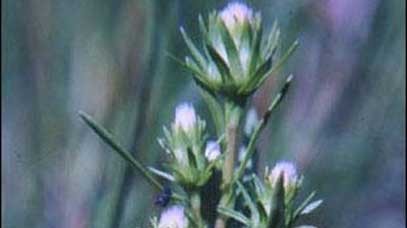
Endangered
- Its unique flowers appear in late summer.

Endangered
The Gulf of Saint Lawrence aster is a coastal or salt marsh plant which finds refuge on very few shores in New Brunswick. It is a small aster, varying from as small as five centimetres to a maximum of 30 cm in height. It has smooth fleshy leaves, typical of many of the plants that grow in a coastal or saline environment. The Gulf of Saint Lawrence aster is unusual among the asters in that it seems to lack petals. In fact, what we think of as aster petals are actually tiny individual flowers called ray flowers. A cluster of a second kind of tiny flower, called tube flowers, forms the centre of the aster blossoms in what often resembles a small button. The Gulf of St. Lawrence aster has only these tube flowers (and perhaps a few rudiments of ray flowers), surrounded by bristles, which gives it the appearance of a small, white to pinkish -coloured paint brush. These unique flowers appear in late August or early September.
The Gulf of St. Lawrence aster occurs in salt marshes, on coastal beaches, and in hollows behind sand dunes. It is usually found in sheltered locations away from direct exposure to strong winds and daily tides, though populations are infrequently covered by extreme high tides and storm floods. Its habitat is very dynamic, as storms and high winds change the shape of shorelines from year to year. This species is well adapted to this shifting habitat. It is an annual plant, which means that it lives for only one year, but also that it grows readily from seed when conditions are right. Because its habitat is variable, the number of seeds that germinate, and thus the number of plants, may vary greatly from year to year. Coastal stewardship, such as protecting salt marshes, is an effective measure in conserving this species.
The Gulf of Saint Lawrence aster occurs only along the coast of north-eastern New Brunswick, on Prince Edward Island and on the Magdalene Islands. It is thus considered to be endemic to the Gulf of Saint Lawrence region. In other words, it is native to and confined to this region.